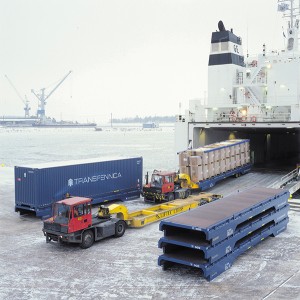
Translifter Cassette system is one of the best practices described in the project. Photo: TTS Liftec Oy
BESTFACT project collects, develops, evaluates and circulates good ideas for city logistics, green logistics and co-modality as well as e-freight. Best practice descriptions (95 so far) are freely available from the project website.
BESTFACT develops, disseminates and enhances the utilisation of best practices and innovations in freight transport that contribute to competitiveness and environmental impact. The core of the BESTFACT concept is to extend existing best practice methodologies towards implementation strategies within an industrial environment. BESTFACT aims to become an active ‘Single Window’ for freight logistics’ best practices, contacts and policies.
Best practice in BESTFACT is considered as existing approach or solution (industrial business cases, measures, administrative procedures, research results) providing a solution for a relevant problem or challenge in freight transport. Best practice considered for BESTFACT is characterised by the following attributes:
- Best practice includes an innovative and feasible approach beyond the common practice
- Best practice addresses both business and policy objectives
- Best practices have considerable and measurable positive effects on strategic business and policy targets
- Best practice should be transferable to other companies, initiatives or contexts
After the second year of the project, we have achieved a total of 95 inventory cases and 30 in-depth reviews of Best Practices. Quick Info Sheets (QIS) are available for all selected Best Practice case. These will provide a short overview of solutions, implementation and further useful information. Overview of the cases with their short description (QIS) and additional information from Workshops, at which the cases have been presented and discussed, are public documents that can be downloaded from the BESTFACT webpage.
An evaluation tool including impact analysis and transferability evaluation has been developed for BESTFACT cases. The guideline for the methodology development has been, while being comprehensive, to keep it relatively easy to understand and transparent. Instead of comparing different cases to each other and pointing out the best ones among all cases, the evaluation methodology shows where the case is most usable or appropriate. The analysis addresses the type of the problem and the circumstances where the results are most useful.
Impact evaluation is based on selected criteria. The criteria consist of strategic targets and topics. The results show the main impacts of each Best Practice case, its main contribution compared to other cases, strategic targets and topics where the case have positive or unfavourable impacts, and assessed transferability. Transferability is assessed based on four different criteria: innovation, feasibility, measurable positive effects and accessible information. In addition, transferability to other organisations or areas is assessed separately.
Most of the cases are focussed on activities occurring at the business level, meaning that one of the core BESTFACT dimension is to better understand the transfer of a solution from one operator to another. Costs and benefits are important dimensions of the information analysis in these cases. Assessment is backed with quantitative CBA figures where applicable.
The BESTFACT conference in 2014 hosted the first Sustainability Award for Freight Transport & Logistics ceremony. Winner of the Urban Freight was case DISTRIPOLIS (Geodis) for their urban consolidation centres and battery-electric vehicles for 13,000 daily last-mile deliveries to french city centres. Winner of Green Logistics & Co-modality was case VIKING Train, a joint project of the Lithuanian, Ukrainian and Belarusian railways, stevedores and ports linking the Baltic and Black Seas to the Mediterranean and Caspian Seas. Winner of eFreight was case KoKoBahn, an electric data exchange platform between seaports, intra-port actors and hinterland railways by DBH Logistics IT and Travemünder Datenverbund. The BESTFACT consortium praised the three award winners for their high impact, making them unique in Europe today.
The BESTFACT consortium includes 18 partners made up of European research institutes, universities, international associations and industry partners, financed by the European 7th RTD Framework Programme project 01/2012 – 12/2015. The central aspect of the project is the identification and promotion of best practices. Other actions are implementation support actions, cluster workshops, conferences, innovative policy schemes, best practice handbook and knowledge platform.
Text: Antti Permala
 Contact: Contact:Antti Permala antti.permala@vtt.fi VTT, Finland |







Follow us: